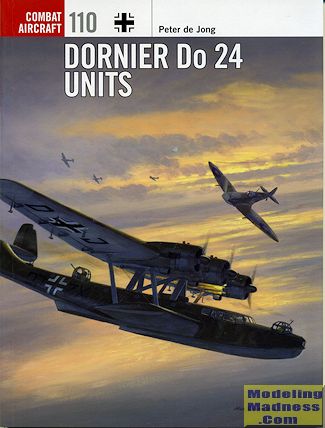 ne
of the nicest looking flying boats of the 1940s was the Dornier Do-24. Built to
a specification that also included the BV-138 for a long range patrol
plane/bomber, the BV-138, despite all the advantages of the Do-24, was chosen as
the winner of the competition by a short-sighted RLM. The brass hats overlooked
the improved range, speed, water handling capabilities, and general superior
flying characteristics of the Do-24 as it was felt that Dornier should stick
with land bombers. So the naval recce folks were stuck with 'the clog'.
ne
of the nicest looking flying boats of the 1940s was the Dornier Do-24. Built to
a specification that also included the BV-138 for a long range patrol
plane/bomber, the BV-138, despite all the advantages of the Do-24, was chosen as
the winner of the competition by a short-sighted RLM. The brass hats overlooked
the improved range, speed, water handling capabilities, and general superior
flying characteristics of the Do-24 as it was felt that Dornier should stick
with land bombers. So the naval recce folks were stuck with 'the clog'.
However, not all was lost for the Do-24. The Dutch realized that, with
better engines, this was exactly the plane they were looking for to be assigned
to their huge Netherlands East Indies territory and so placed a substantial
order along with a license to build the plane. The Dutch were very happy with
their new plane and as soon as they could be built, they were sent to the East
Indies. Eventually all the Dornier built planes were delivered with the last
Dutch built plane, #37, leaving for the Indies just days before Holland was
overrun by the German army.
With war fully underway, the Luftwaffe came to the realization that the
aircraft currently in use for air/sea rescue, the He-59, was not exactly the
best choice, especially as it was not able to land in much anything other than
the smoothest seas, a condition that was not always available. So they put BMW
radials on the Do-24 in place of the prototype's diesels and it became their new
ASR plane. Initially painted white and unarmed, the ASR groups found themselves
being shot down by the British as the Brits thought they were actually spying. A
removal of the white paint and red crosses followed and the guns were put back
into the planes for the duration of the war.
The Do-24 eventually became the main plane in terms of ASR work and
operated throughout the war zones from Norway to the Greek Islands. It was also
built in occupied France.
Moving back a bit, the first users of the plane, the Dutch, found them
in the middle of a war in the East Indies against the Japanese. There the
aircraft were used for patrol, some bombing, ASR and evacuation of Europeans as
the Japanese closed the circle. Many were shot down or destroyed on the water
with only a handful surviving to escape to Australia.
Other nations also used the Do-24 with the biggest users outside the
Dutch and the Germans being the Spanish. They kept their Do-24s in limited use
even after being replaced by SA-16 Albatrosses, retiring the last one in 1969.
The book covers the little told story of the Do-24 in Dutch service as
well as their exploits in the far north, Europe and the Mediterranean. There are
lots of great period photos and the usual pages of profiles one always gets with
this series. Osprey seems to be changing its cover images as this book has a new
cover format from previous editions. To my knowledge, this is at least the
fourth change. In all, it is a fascinating read about a plane that actually saw
more service than many would have thought. A book that I can highly recommend to
you.
May 2015
For more on the complete line of Osprey books,
visit http://ospreygrp.com. In the US, e-mail
OspreyUSA@ospreypublishing.com, to request a catalogue of available books.
If you would like your product reviewed fairly and
fairly quickly, please
contact the editor or see other details in the
Note to
Contributors.
 ne
of the nicest looking flying boats of the 1940s was the Dornier Do-24. Built to
a specification that also included the BV-138 for a long range patrol
plane/bomber, the BV-138, despite all the advantages of the Do-24, was chosen as
the winner of the competition by a short-sighted RLM. The brass hats overlooked
the improved range, speed, water handling capabilities, and general superior
flying characteristics of the Do-24 as it was felt that Dornier should stick
with land bombers. So the naval recce folks were stuck with 'the clog'.
ne
of the nicest looking flying boats of the 1940s was the Dornier Do-24. Built to
a specification that also included the BV-138 for a long range patrol
plane/bomber, the BV-138, despite all the advantages of the Do-24, was chosen as
the winner of the competition by a short-sighted RLM. The brass hats overlooked
the improved range, speed, water handling capabilities, and general superior
flying characteristics of the Do-24 as it was felt that Dornier should stick
with land bombers. So the naval recce folks were stuck with 'the clog'.